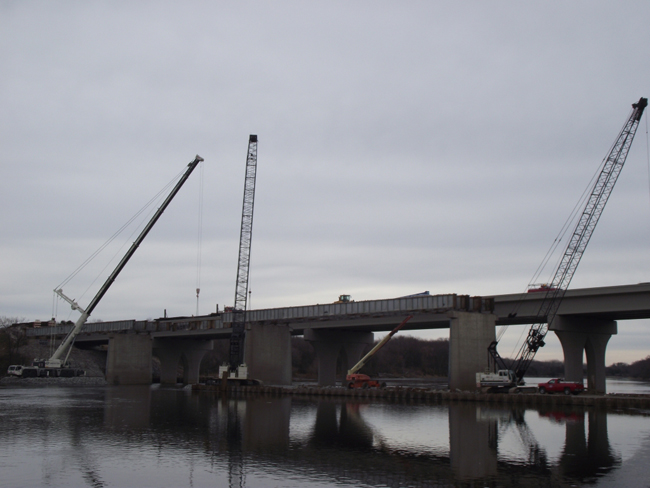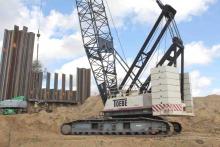
The Minnesota Highway 24 Bridge spanning the Mississippi River at Clearwater is not a major structure. However, it does play a key role as the 376.4m-long bridge links US Highway 10 and Interstate 94. These routes run parallel on opposite sides of the Mississippi River and connect St Cloud to Minneapolis.
There was a need to replace the old bridge, built in the 1950s, as it has been designated functionally obsolete, while it featured a restricted maximum load of 36.3tonnes.
The price tag to demolish and replace the outdated Highway 24 Bridge came in at US$17.4 million. To help with its replacement, two
With the new structure complete, the contractor then carried out the demolition and removal of the old bridge structure. This tricky task had to be completed without damaging the new bridge or contaminating the river, and work had to be completed within around 10 months.
For deck girder removal from the centre and east bridge spans, a specialised piece of crane equipment was required. With the east causeway being short and narrow, the company needed a compact mobile crane with high capacity and long boom to help with centre span lifts and one that could navigate the road embankment access to the causeway. St Cloud, MN-based Landwehr Construction, was called in for consultation.
The distance from road level to river was about only 16.8m, but the contractor only had about 15.2m of room to make a 90° corner to position the crane on the causeway. This east causeway measured only 21.3m wide by approximately 12.2m long. The west causeway, where the HC 165 worked from, was approximately 137.2m wide, which left some 44.2m of space inbetween for the river.
The bridge’s four centre I-beam girders were cut to 29.9m lengths and weighed 19.5tonnes each. The plan called for a tandem lift between the HC 165 crawler crane and Landwehr’s crane, which required working at a radius of 36.6m. In addition to assisting with centre span removal, Landwehr was contracted to remove four east-span girders, each 41.8m long and weighing 30.4tonnes apiece.
One crane in Landwehr’s fleet offered the combination of capacity, boom length and compact design to manoeuvre into position and complete the lifts, its 350tonne capacity class AC 350/6 all-terrain crane. Girder weights and boom working radius required the AC 350/6 to be equipped with its superlift structure to meet capacity. However, the causeway size did not allow enough room for the superlift to be installed at river level. Instead the crane’s superlift structure had to be installed at road level with the assistance of the HC 110.
Once at the staging area, the HC 110 crane helped to install the superlift structure. In operating position with its front axle close to the edge of the causeway, trucks carrying the counterweight stacks were sent to river level to be installed. After installing 116.7tonnes of counterweight, the superlift connections were made to complete rigging.
For centre girder removal, the AC 350/6 crane’s boom was telescoped to 54.2m. Working at the 36.6m radius offered a crane capacity of 18.1tonnes, sufficient to remove the centre girders in the tandem lift with the Terex HC 165 crawler crane.
The girders were hoisted onto trucks staged on the new bridge and transported the short distance to a processing area, where the HC 110 crane removed the beams.
The four east steel girder spans were then removed. Working with a 49.7m boom length and a 23.2m radius, the AC 350/6 hoisted the final 41.8m long girders weighing 30.4tonnes each in less than eight hours. In less than three days, Landwehr mobilised and rigged the Terex AC 350/6 all-terrain crane, completed eight girder lifts, and moved onto the next job.










